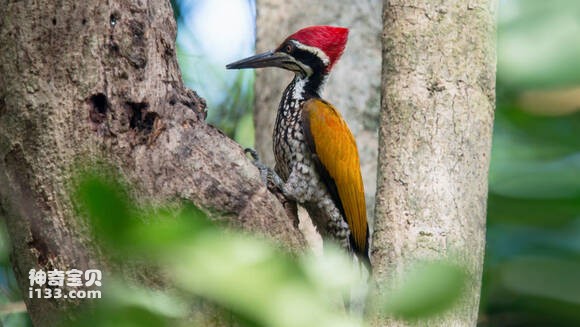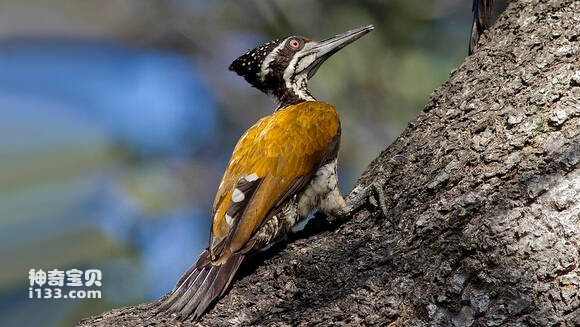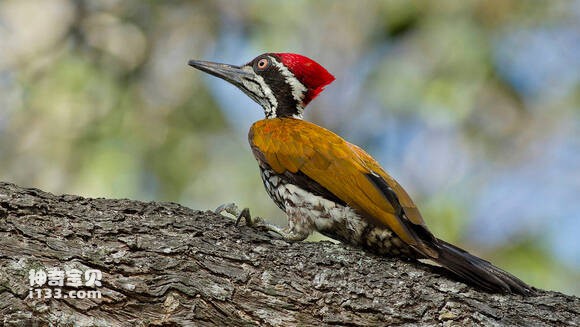Chrysocolaptes guttacristatus
IUCN
LCBasic Information
Scientific classification
- name:Chrysocolaptes guttacristatus
- Scientific Name:Chrysocolaptes guttacristatus,Greater flameback
- Outline:Climbing birds
- Family:
Vital signs
- length:31-35 centimeters
- Weight:232-240g
- lifetime:There are currently no research materials available
Feature
Distribution and Habitat
The Great Golden backed Woodpecker is distributed on Mint Island, Wright Island, Samar Island, Billand Island, Panaon Island, Mindanao Island, Brazilians Island, and Samar Island in the Philippines.
The big golden backed woodpecker prefers open forests and forest edges. It mainly inhabits low mountain and plain evergreen broad-leaved forests and mixed forests below an altitude of 1500 meters, and also appears at forest edges and sparse forests.
Appearance
The body length of the Big Golden backed Woodpecker is about 31 centimeters. The head and crown feathers are deep red, and the back neck is white; The back, shoulders, and wings (except for the primary flight feathers and the outer covering feathers, which are dark brown with white spots) are all olive colored; Deep red waist; Tail covered with feathers and black tail. There is a white eyebrow line and a wide black eye line extending to the side of the neck. White cheeks, chin, and throat, with 5 narrow black horizontal spots; The remaining parts of the lower body are dark white, with black edges on each feather (wider at the chest and narrowest at the abdomen). Iris red and yellow; Mouth slate gray; The tarsals and toes are light green brown.
The female bird has black dots on its entire head and feather crown, while the rest are the same as the male bird. The head color of a young bird is similar to that of a female bird. The red color on the top of the male's head quickly app
Details
The scientific name of the Great Golden backed Woodpecker is Chrysocolaptes guttacristatus, also known as the Great Flameback. It has three subspecies.

The big golden backed woodpecker often moves alone or in pairs. Activity and foraging throughout the entire tree. Frequently fly from one tree to another, chirping while flying. Sometimes they also go to the ground to forage for ants and insects. When climbing along tree trunks for food, they often moan. The call was rough and sharp. Paired activities, sometimes with loud chiseling sounds. The sound is loud and piercing, with an explosive scream like a giant cicada's roar.

The Great Golden backed Woodpecker mainly feeds on various insects, as well as worms and other small invertebrates. During the autumn and winter seasons, we also eat fruits and seeds of plants.

The breeding period of the Golden backed Woodpecker is from March to May. Nesting is done on trees in evergreen broad-leaved forests, as well as in sparse forests mixed with bamboo forests, and even on dead trees near farmland. The heartwood of the nesting trees is mostly decayed and easy to pick and chisel. The opening of the nest is relatively large, mostly around 7-8 centimeters, with a depth of 15-40 centimeters. The height of the opening from the ground is usually 1.5-6 meters. Each litter lays 4-5 eggs, occasionally as many as 6 or as few as 3 and 2. Egg white, with a size of 26-33 x 20-24 millimeters.
Listed in the IUCN Red List of Endangered Species (2016 ver 3.1- Least Concerned (LC)).
Listed in the list of beneficial or economically and scientifically significant terrestrial wildlife protected by the state, released by the State Forestry Administration of China on August 1, 2000.
Protect wild animals and eliminate wild game.
Maintaining ecological balance is everyone's responsibility!








